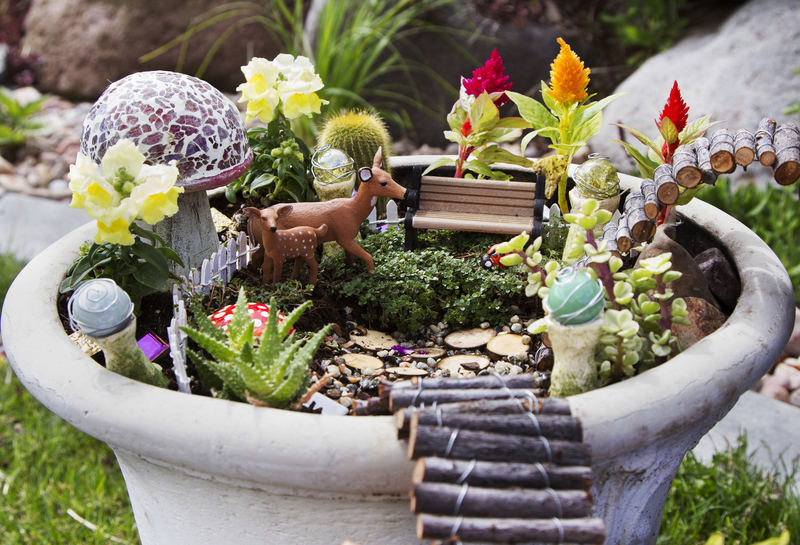Plant Your Passion: Guide to Herb Gardening
Posted on 16/06/2025
Plant Your Passion: Guide to Herb Gardening
Are you ready to start your journey towards fresh, flavorful, and aromatic delights direct from your garden? Herb gardening is not just a hobby--it's a passion that weaves together relaxation, nature, culinary joy, and wellness. Whether you have a sprawling backyard, a tiny balcony, or simply a sunny window ledge, you can grow herbs and enjoy their myriad benefits. In this in-depth guide, you'll discover everything you need to know about planting, nurturing, and harvesting your own herb garden, tailored for beginners and green thumbs alike.
Why Grow Your Own Herb Garden?
Herbs have been cultivated for centuries for their culinary, medicinal, and ornamental values. Growing your own herbs comes with a host of benefits that extend far beyond the kitchen. Let's explore the joy of cultivating your personal supply of fresh herbs.
- Freshness: Homegrown herbs are vibrant, fragrant, and bursting with flavor, far superior to store-bought options.
- Cost-effective: Once established, herb gardens can save you money and trips to the grocery store.
- Health Benefits: Most herbs are loaded with antioxidants, vitamins, and essential oils.
- Easy to Grow: Many herbs thrive in small spaces, and some are even ideal for beginners.
- Environmental Impact: Reduce your carbon footprint by eliminating packaging and transportation involved in buying herbs.
Ready to plant your passion and embrace the art of herb gardening? Let's begin with the essentials.

Choosing the Right Herbs for Your Garden
Selecting the appropriate herbs is the crucial first step. Consideration of your climate, available space, and how you plan to use the herbs will guide your choices. Here's a list of popular and beginner-friendly herbs:
Culinary Favorites
- Basil: Perfect for Italian dishes, pesto, and fresh salads.
- Parsley: Flat-leaf and curly varieties; great for garnishing and flavoring soups.
- Chives: Mild onion flavor, ideal for salads and baked potatoes.
- Cilantro: Essential in Mexican, Indian, and Middle Eastern cuisines.
- Oregano: Robust and aromatic, perfect for Mediterranean dishes.
- Mint: Refreshing addition to drinks and desserts, but can spread aggressively.
- Rosemary: Woodsy and sharp, great with roasted meats and potatoes.
- Thyme: Versatile and easy to grow, used in a variety of recipes.
- Dill: Pairs beautifully with fish and in pickling.
- Sage: Deeply savory, perfect for stuffing and sausages.
Medicinal & Special Use Herbs
- Lemon Balm: Known for calming teas and natural remedies.
- Lavender: Fragrant for home decor, teas, and skin care.
- Chamomile: Perfect for soothing bedtime teas.
- Echinacea: Renowned immune booster.
- Calendula: Vibrant blooms with healing properties.
Herb Garden Planning: Where and How to Grow
Designing your herb garden space is a rewarding part of the process. From window boxes to raised beds, herb gardening can adapt to almost any environment.
Indoor vs. Outdoor Herb Gardens
- Indoor Herb Gardening: If you have limited outdoor space, windowsills or kitchen counters with ample sunlight are ideal. Use containers with good drainage and nutrient-rich potting mix.
- Outdoor Herb Gardening: Enjoy more variety and abundance in a garden bed, raised container, or vertical garden. Select a site with at least 6 hours of sunlight daily and well-draining soil.
Container or Ground Planting?
Herbs adapt beautifully to containers, making them perfect for patios and small spaces. Use terra cotta pots, window boxes, or even recycled containers, ensuring each has drainage holes. If planting directly in the ground, enrich soil with compost and consider raised beds for easier maintenance and improved soil quality.
Herb Garden Location
- Select a spot that receives at least 6-8 hours of sunshine daily.
- Keep culinary herbs close to the kitchen for easy access while cooking.
- Make sure water is accessible for convenience.
- Take wind, pets, and children into consideration for placement and safety.
Starting Your Herb Garden: Seeds vs. Seedlings
You can start your herb garden from either seeds or young plants (seedlings). Each method has its pros and cons.
- Seeds: More economical and offer a wider selection. However, some herbs are slow to germinate or require special conditions.
- Seedlings: Quicker and easier for beginners. Buying healthy seedlings from a nursery bypasses the delicate germination stage.
*Some herbs, like basil, cilantro, and dill, grow reliably from seed. Others, such as rosemary and thyme, are best started from cuttings or seedlings due to slow growth.*
How to Plant Herbs: Step-by-Step Guide
Ready to plant your passion and start your herb garden? Follow these steps to ensure your herbs thrive:
1. Prepare the Soil
- Use well-draining soil: Herbs don't like soggy roots. Amend your soil with compost or organic matter for nutrients.
- Check pH: Most herbs prefer slightly alkaline to neutral soil (pH 6.0-7.5).
- Loosen the earth: If planting in ground, break up hard clumps for better root penetration.
2. Planting Seeds or Seedlings
- Follow packet instructions for seed depth and spacing. Some herbs, like basil, need warmth; others, like parsley, benefit from pre-soaking seeds.
- Gently remove seedlings from pots, loosen roots, and plant at the same depth as their original container.
3. Watering Your Herbs
- Water gently and consistently. Overwatering causes root rot; underwatering leads to wilting. Let the topsoil dry slightly between waterings.
- Morning watering is best, reducing chances of fungal disease.
4. Mulching (Optional but Beneficial)
- Apply a thin layer of organic mulch (such as straw or shredded leaves) to help retain moisture and reduce weeds.
Herb Garden Care and Maintenance
Nurturing your herb garden ensures robust and healthy growth year-round. Here's how to protect and nourish your passion:
Sunlight
- Herbs crave sunlight. If indoors, rotate containers to ensure even exposure.
Fertilizing
- Most herbs thrive on lean soil. Over-fertilization leads to lush growth but diluted flavor. Use organic liquid fertilizers sparingly every 4-6 weeks.
Pruning and Harvesting
- Pinch off flower buds to encourage bushier growth (especially basil and mint).
- Harvest leaves regularly--frequent trimming produces more growth and extends the harvest season.
Pest and Disease Control
- Check leaves regularly for pests (aphids, spider mites) and organic diseases (powdery mildew).
- Use neem oil, insecticidal soap, or introduce beneficial insects like ladybugs.
Winter Care
- Perennial herbs (rosemary, thyme, mint) may die back in winter but return in spring. Protect them with mulch or bring containers indoors in frost-prone areas.
- Annuals (basil, cilantro) complete their cycle; collect seeds for next season.
Harvesting and Using Your Herbs
One of the most rewarding aspects of herb gardening is harvesting fresh, vibrant ingredients. Here's how to maximize flavor and shelf-life:
- Morning Harvest: Pick herbs after dew dries but before midday sun, when oils are most concentrated.
- Cut Properly: Use sharp scissors, cutting just above a leaf pair to encourage regrowth.
- Storage: Wrap stems in barely damp paper towels and store in airtight containers or jars of water in the fridge.
- Dry or Freeze: Preserve extra herbs by air drying (hanging bundles upside down) or freezing in oil or water in ice cube trays.
Creative Ways to Use Fresh Herbs
Herbs elevate every meal and can be used for far more than just cooking. Some popular ideas:
- Add basil, oregano, and thyme to sauces, soups, and stews for robust flavor.
- Craft herbal teas with mint, chamomile, and lemon balm for relaxation or digestion.
- Infuse herbs into oils, vinegars, and butters to preserve flavors and enhance dishes.
- Make homemade beauty products: salves with calendula and lavender, mint scrubs, or rosemary shampoo rinses.
- Decorate your home with fragrant bouquets of freshly picked herbs.
Troubleshooting Common Herb Gardening Problems
Even seasoned gardeners encounter challenges. Here are solutions to common herb garden issues:
- Leggy Growth: Herbs aren't getting enough light. Move them to a sunnier spot.
- Yellow Leaves: Usually due to overwatering or poor drainage. Improve drainage and adjust watering schedule.
- Pests: Remove by hand, use neem oil, or introduce natural predators.
- Fungal Diseases: Ensure proper spacing for airflow, water at the base, and mulch sparingly.
- Herbs Not Thriving Indoors: Supplement with grow lights or choose herbs better suited to indoor conditions like chives and parsley.

Advanced Herb Gardening: Tips for Expert Results
- Try successive sowing for a continual harvest (especially cilantro and basil).
- Experiment with unusual herbs like lovage, stevia, or Vietnamese coriander.
- Make a themed herb garden--pizza, tea, or medicinal herb collections.
- Practice companion planting: basil with tomatoes, dill with cabbage, or chives with carrots to repel pests.
- Save seeds from annuals to reuse each year and share with fellow gardeners.
Conclusion: Nurture Your Green Passion
Herb gardening is a rewarding journey that invites you to connect with nature, savor bold flavors, and infuse your life with fragrance and well-being. From simple pots on a windowsill to a lush backyard paradise, growing herbs is accessible to all. Embrace the fulfillment of cultivating your own herbs--plant your passion, and let your garden flourish!
Whether you seek a mindful weekend project or a way to transform daily meals, the world of herb gardening is just a seed away. Start today--and revel in your garden's growth, beauty, and abundance for seasons to come.



